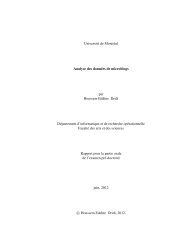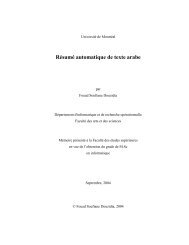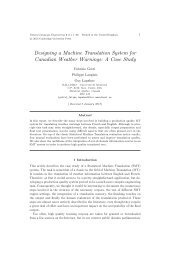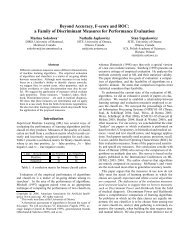A Corpus-based Approach to Weather Report Translation - RALI ...
A Corpus-based Approach to Weather Report Translation - RALI ...
A Corpus-based Approach to Weather Report Translation - RALI ...
- No tags were found...
You also want an ePaper? Increase the reach of your titles
YUMPU automatically turns print PDFs into web optimized ePapers that Google loves.
MONDAY .. CLOUDY PERIODS IN THE MORNING WITH 30 PERCENT CHANCE OF FLURRIES EARLY<br />
IN THE MORNING .<br />
preprocessing<br />
DAY1 PONCT1 CLOUDY PERIODS IN THE MORNING WITH INT1 PERCENT CHANCE OF<br />
FLURRIES EARLY IN THE MORNING PONCT2<br />
memory<br />
nearest source match (edit distance=3):<br />
DAY1 PONCT1 BECOMING CLOUDY EARLY<br />
IN THE MORNING WITH INT1 PERCENT<br />
CHANCE OF FLURRIES IN THE MORNING<br />
PONCT2<br />
↕<br />
DAY1 PONCT1 DEVENANT NUAGEUX TOT<br />
EN MATINEE AVEC POSSIBILITE DE INT1<br />
POUR CENT D AVERSES DE NEIGE EN MATINEE<br />
PONCT2<br />
⇓<br />
⇓ translation ⇓<br />
selection<br />
SMT<br />
DAY1 PONCT1 NUAGEUX AVEC PERCEES<br />
DE SOLEIL EN MATINEE AVEC INT1 POUR<br />
CENT DE NEIGE TOT EN MATINEE PONCT2<br />
DAY1 PONCT1 NUAGEUX AVEC NEIGE<br />
PASSAGERE EN MATINEE AVEC POSSIBILITE DE<br />
INT1 POUR CENT DE NEIGE TOT LE MATIN<br />
DAY1 PONCT1 DEVENANT NUAGEUX TOT EN MATINEE AVEC POSSIBILITE DE INT1 POUR<br />
CENT D AVERSES DE NEIGE EN MATINEE PONCT2<br />
postprocessing<br />
LUNDI .. DEVENANT NUAGEUX TOT EN MATINEE AVEC POSSIBILITE DE 30 POUR CENT D<br />
AVERSES DE NEIGE EN MATINEE .<br />
Reference translation :<br />
LUNDI .. PASSAGES NUAGEUX EN MATINEE AVEC 30 POUR CENT DE PROBABILITE D AVERSES<br />
DE NEIGE TOT EN MATINEE .<br />
Figure 3: Illustration of a translation session. The source sentence is first preprocessed. Both the<br />
memory and the SMT engine are queried. Here, the memory found only an approximative match<br />
with an edit distance of 3. The two first translations produced by the SMT engine are reported on<br />
the right column. A translation is then selected and postprocessed.<br />
possibilite de). This process is different from<br />
the creation of specialized lexicons used in the<br />
current Météo system. In particular, we did<br />
not try <strong>to</strong> join words that might be handled<br />
badly by our models (such as greater Vancouver<br />
↔ Vancouver et banlieue) nor did we explicitly<br />
encode place names. We only used au<strong>to</strong>matic<br />
<strong>to</strong>ols for building the system.<br />
3.2 The translation memory<br />
When we started <strong>to</strong> build a translation memory<br />
for our pro<strong>to</strong>type, we identified several parameters<br />
that could significantly affect the performance<br />
of the system. The main ones are its size<br />
and the number of French translations kept for<br />
each English sentence.<br />
The size of the translation memory affects<br />
our system in two ways. If we s<strong>to</strong>re only the<br />
few most frequent English sentences and their<br />
French translations, the time for the system <strong>to</strong><br />
look for entries in the memory will be short.<br />
But, on the other hand, it is clear that the bigger<br />
the memory, the better will our chances be<br />
<strong>to</strong> find sentences we want <strong>to</strong> translate (or ones<br />
within a short edit distance) even if these sentences<br />
were not frequent in the training corpus.<br />
We can see on fig. 4 that the percentage of sentences<br />
<strong>to</strong> translate found directly in the memory<br />
grows logarithmically with the size of the memory<br />
until it reaches approximately 20 000. With<br />
a memory of 320 000 sentences, we can obtain a<br />
peek of 85% of sentences found in<strong>to</strong> the memory.<br />
The second parameter for the translation











